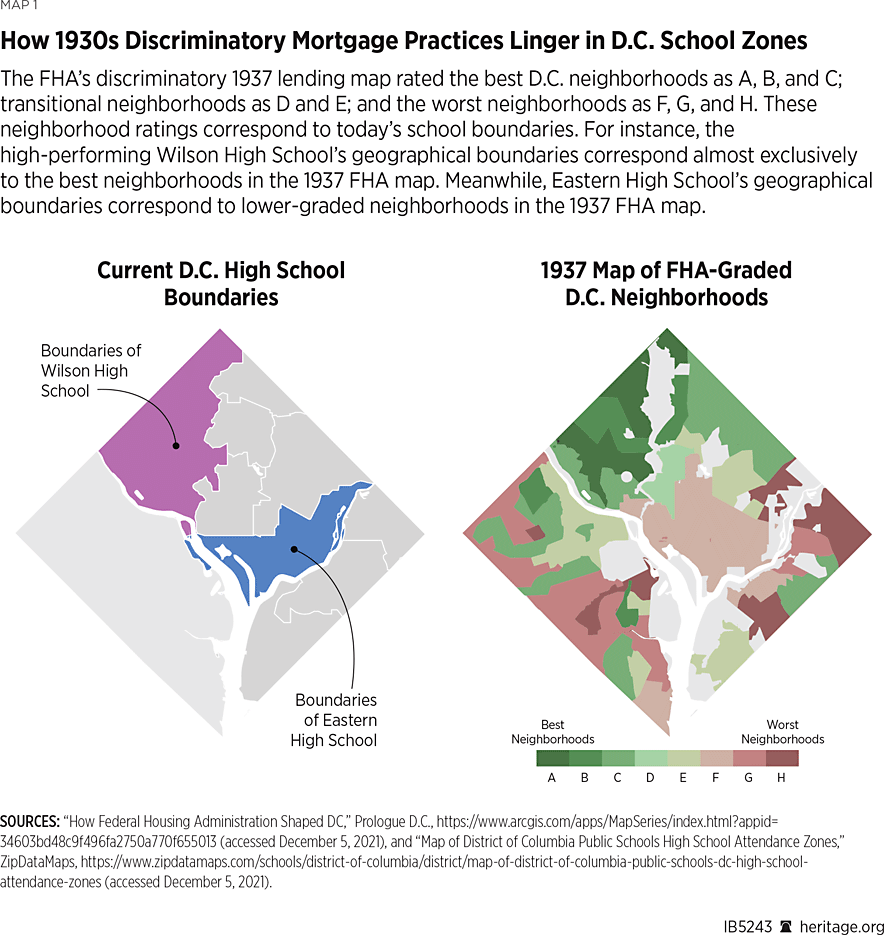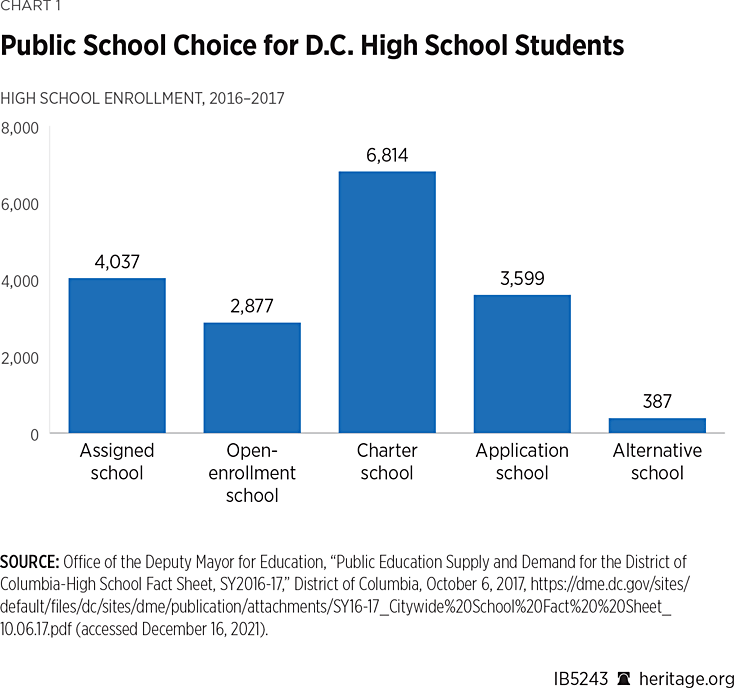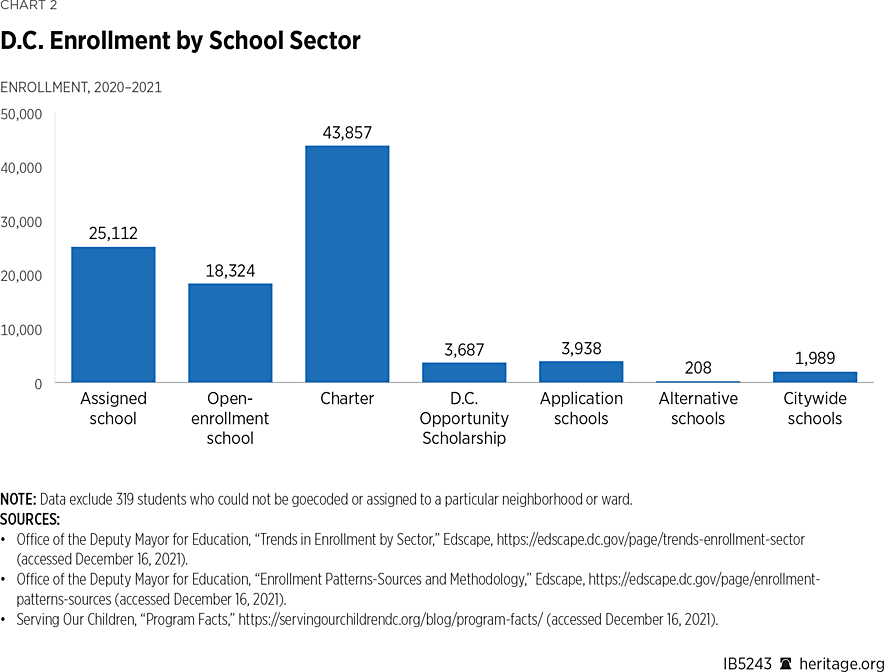During the 20th century, federally sanctioned housing “redlining” influenced the composition of neighborhoods in large cities across the country, including Washington, D.C. The term “redlining” came from the color-coded maps developed by the Home Owners Loan Corporation (HOLC) (on which mortgage lending under the Federal Housing Administration (FHA) was partly based). The HOLC limited access to federally backed mortgages for home loans in the red-colored and lowest-grade neighborhoods described as “hazardous.”REF
Although Congress outlawed discriminatory lending policies in the mid-20th century, prior government practices had created geographic concentrations of lower-income families. Coupled with residential assignment of schooling, which is largely maintained by school districts today, many schools remain racially and economically segregated. Unlike many other metropolitan cities throughout the United States, however, Washington, D.C., has effectively overcome the barriers imposed by geographic school boundaries through open enrollment, a robust charter school sector, and a private school scholarship program. States should follow this lead, and, at the same time, take steps to prohibit school districts from drawing attendance zone boundaries within their borders.
How the Federal Housing Authority Shaped D.C.’s Neighborhoods
Although there is no record of a HOLC map of Washington, D.C., a graded map created by the FHA exists. Washington, D.C.’s FHA map ranks neighborhoods in descending order A, B, C, D, E, F, G, and H. The FHA’s neighborhood descriptions cite race as a depressing factor or as intentionally segregated for areas zoned as F, G or H.REF In current day D.C., these lower grade neighborhoods occupy many of the various neighborhoods surrounding the National Mall, the U.S. Capitol, and bordering on or east of the Anacostia River.REF
FHA mortgage lending practices deeply impacted D.C. residents’ housing options, intentionally segregating populations to protect neighborhoods from “inharmonious racial groups.”REF Education scholars Todd M. Michney and LaDale Winling note that despite being “a longtime center of black homeownership,” Washington, D.C., ranked last on a list of metropolitan cities where black homeowners were able to access FHA loans.REF
The FHA understood that the link between housing and education was a key factor to keeping neighborhoods segregated. “[I]f the children of people living in such an [desirable] area are compelled to attend school where the majority or a considerable number of the pupils represent a far lower level of society or an incompatible racial element, the neighborhood under consideration will prove far less stable and desirable than if this condition did not exist,” the agency’s Underwriting Manual stated.REF
The FHA’s discriminatory government lending practices eventually became illegal through a series of federal changes. The 1968 Fair Housing Act prohibited racial discrimination in the sale or lease of a house. During the next decade, Congress passed the 1974 Equal Credit Opportunity Act, which prohibited discrimination on the basis of race, sex, or marital status, and the 1977 Community Reinvestment Act, which prohibited redlining neighborhoods.REF
While these legislative reforms made government redlining illegal, they did not address the connection between housing and schooling and the lingering effect housing redlining had on education opportunity.
The FHA’s Lingering Footprint on D.C. School Boundaries
Despite these discriminatory government policies ending more than four decades ago, the FHA’s housing policy left a lingering imprint on D.C.’s neighborhoods, especially regarding education. Even today, D.C.’s school boundaries are reminiscent of the FHA’s graded map of Washington, D.C. Each high school has various nearby elementary and middle schools that operate as feeder schools. The school zones for Eastern, Cardozo, Woodson, and Anacostia High Schools cover many of the same neighborhoods that were graded as F, G, or H by the FHA. Whereas the school zones for Wilson, Roosevelt, Coolidge, and Dunbar High Schools occupy many of the neighborhoods that received superior grades from the FHA.REF

For instance, the highly coveted Wilson High School is nestled in the city’s Northwest quadrant where nearly all neighborhoods within its school boundaries, with the exception of one, were graded in the top three tiers by the FHA. At the same time the entirety of Eastern High School’s boundaries falls within neighborhoods that the FHA graded in the lowest three tiers. In many cases these school boundary lines reflect the exact lines imposed by the FHA, even down to the street level.REF
Severing the Link Between Housing and Schooling in D.C.
Open Enrollment. Despite government redlining in the housing sector in the early- to mid-20th century, unlike many other metropolitan cities throughout the United States, Washington, D.C., has effectively overcome the barriers imposed by geographic school boundaries through intra-district open enrollment that allows students to transfer across attendance zone boundaries.REF This policy allows families residing in D.C. to enroll their children in any public school through a randomized lottery.
Families enter their children in a randomized lottery through a common application, ranking up to 12 different schools of their choice for each child. Every student has an automatic placement in his or her neighborhood school. However, families dissatisfied with that placement can seek placement at out-of-boundary schools through the lottery system. For out-of-boundary schools, the only preference provided by the lottery’s algorithm is for students who have siblings already enrolled in that school. Otherwise, all students are weighted equally.REF
Students whose lottery number is not selected remain on the school’s waitlist, allowing students to transition to their preferred school if an opening becomes available. Parents can track the status of their children’s lottery numbers through their My DC School accounts.REF As Stanford University’s Alvin Roth, the creator of the algorithm for D.C.’s lottery system explains:
The model gives students who don’t get their first choices just as much chance of getting their second choices as if they had ranked their second choices as their first choices, permitting every family to put the schools they want most to attend at the top of their lists and putting more students in schools they want to be in. Children who grow up in poorer neighborhoods shouldn’t be condemned to go to poorer schools.REF
D.C. Opportunity Scholarship Program. In 2004, the D.C. Opportunity Scholarship Program (OSP), a private school scholarship for low-income children residing in the federal city, was signed into law. Eligible K–12 students enter a lottery to receive a scholarship to pay for tuition at any participating private school. Since 2004, the OSP has served a total of 10,608 students. In 2020, the program provided 1,835 students with schooling at one of the 42 participating private schools.REF
Serving Our Children, a nonprofit organization that administers the scholarship program, recently announced that K–8 students and high school students will respectively receive $9,401 and $14,102 vouchers for the 2021–2022 academic year. Scholarships must pay for tuition first; however, leftover funds can pay for approved education expenses, such as uniforms, books, before and after care, field trips, and public transportation.REF
Rigorous research indicates that students who apply for and use a scholarship to attend a private school through the OSP are 21 percentage points more likely to graduate from high school than their peers.REF At the same time, the OSP helps students escape from unsafe learning environments. According to a 2020 review of the literature on school safety, private schools are more likely to be perceived as safe by parents, students, and principals.REF In fact, a 2019 study found that OSP students were 34 percent more likely to view their private school as “very safe” than students who were not offered scholarships.REF Despite these advantageous findings and massive program oversubscription, only one in five students who applied in 2020 received a scholarship, as demand outstripped scholarship supply.
D.C. Charter School Sector. Congress’ 1995 School Reform Act allowed the first D.C. charter school to open the following year with 160 students.REF Since then, 133 charter schools have opened in the city, serving 31,803 students—more than 42 percent of D.C.’s total K–12 student population during the 2020–2021 academic year.REF Charter schools are publicly funded schools that operate with greater autonomy than their district-run counterparts. At the same time, charter schools have no geographic attendance zones, so any student living inside D.C. can enroll.
Charter schools determine admission through a randomized lottery. Students apply for admission through the same common application used by district-run schools. Starting in fall 2022, D.C. charter schools can opt to prioritize “at-risk” children so they have a better chance of matching with their preferred school. At-risk students are defined as those who are eligible for public benefits, are in foster care, are over-age in high school, or are experiencing homelessness.REF
According to the DC Public Charter School Board, nearly 13,000 openings were available in D.C. charter schools for the 2021–2022 school year. Forty-six percent of public charter school openings were at Tier 1 schools, which are the highest-ranked charter schools in the region. Most of the 7,822 wait-listed applicants—three-quarters of them—sought enrollment at a Tier 1 charter school.REF
D.C. Families Exercising Choice
According to the D.C. Policy Center, nearly 75 percent of students residing in the nation’s capital attended schools that were not their in-boundary school during the 2016–2017 academic year.REF Enrollment at in-boundary schools decreased most in D.C.’s high schools as families employed a variety of education options. In fact, 16 percent enrolled at out-of-boundary schools, 20 percent enrolled at application schools (schools outside a student’s boundary school), and 39 percent enrolled at D.C. charter schools.REF

While a variety of factors affected parents’ decision to enroll their children at their in-boundary school, the DC Policy Center’s research indicated that living in a neighborhood that was inside the Wilson High School “boundary or feeder pattern is the key variable in explaining whether students attend their in-boundary school.”REF This year, Wilson High School was one of D.C.’s top-ranked public high schools with a geographic attendance zone.REF In fact, living within the Wilson High School boundaries or feeder pattern boosts in-boundary enrollment by 24 percentage points. Varying factors could affect Wilson High School’s higher enrollment, such as academics, extracurricular activities, and student demographics. However, education researchers noted that Wilson High School is insulated from charter school competition since there are no charter schools within its geographic boundaries, whereas other district schools must compete with charter schools for student enrollment.REF
Outside Wilson High School’s boundaries and feeder pattern, most families take full advantage of the various school choice options. In 2016–2017, 7 percent of students enrolled in charter schools inside the zone for their in-boundary school. At the same time, 43 percent of students were enrolled at an out-of-boundary school or charter school that was not inside the zone for their in-boundary school.REF D.C. families are eager to use student-centered education options that decouple schooling from housing.

Conclusion
D.C. has policies in place that mitigate the lingering effects of government housing redlining on education opportunity. No longer tethered by their homes’ geographic location, families can utilize the city’s open-enrollment policy to apply to the public school of their choice.
Open enrollment has helped minimize the effects of the FHA’s past policies. Policymakers should maintain and expand opportunities for education choice, such as open enrollment, charter schools, and the D.C. Opportunity Scholarship Program. Ultimately, Congress should transition the District of Columbia into an all-choice district, giving every family access to the D.C. Opportunity Scholarship Program. These educational alternatives allow for a robust education marketplace and help break down the barriers that lock children in assigned schools based on their geographic location.
Jude Schwalbach is an Education Policy Analyst at The Reason Foundation.


